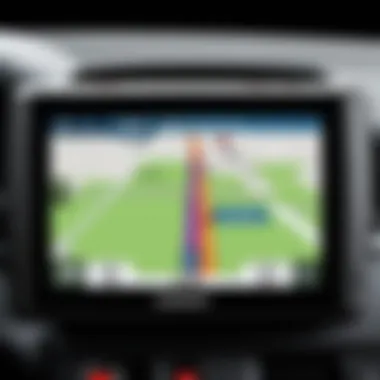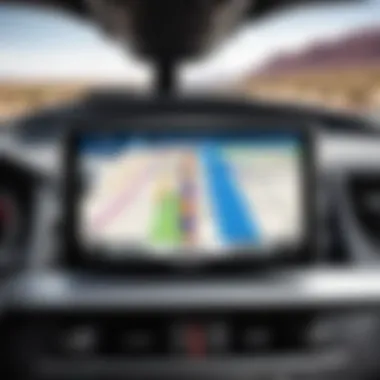In-Depth Analysis of Garmin Nuvicam LMTHD GPS


Intro
In the realm of navigation technology, the Garmin Nuvicam LMTHD GPS stands out as a notable choice for both casual users and tech enthusiasts. As global positioning systems evolve, keeping abreast of the latest models is crucial for informed decision-making. The Nuvicam LMTHD presents a blend of performance, features, and usability, making it relevant in today’s digital landscape. This article aims to delve into the intricacies of this device, exploring its specifications, practical applications, and how it aligns with the needs of IT professionals.
Product Overview
The Garmin Nuvicam LMTHD GPS is equipped with a variety of features tailored to enhance navigation. At first glance, its 7-inch display captures attention, providing a clear interface for users. The device supports high-definition graphics, contributing to enhanced map clarity.
Key Features
- HD Digital Traffic: Real-time traffic data helps avoid congested routes, allowing for a smoother travel experience.
- Voice Command Functionality: Many users appreciate hands-free navigation, enabling safer operation while driving.
- Premium Maps: The Garmin Nuvicam offers detailed maps of North America, including updates, which can be a significant advantage for frequent travelers.
- Built-in Dash Cam: One of its standout features is the integrated dash camera, which records the road ahead for added safety and accountability.
- Customizable Points of Interest: Users can add their favorite locations, ensuring the GPS meets their specific requirements.
Technical Specifications
Understanding the device's technical specifications can help users grasp its full potential:
- Display Size: 7 inches (capacitive touch)
- Resolution: 1024 x 600 pixels
- Battery Life: Up to 2 hours (internal rechargeable)
- Weight: Approximately 0.77 pounds
- Connectivity: Bluetooth capabilities for hands-free calls and smartphone link functionality
Performance Analysis
Benchmark Test Results
In various benchmark tests, the Garmin Nuvicam consistently demonstrates quick calculation times for routes. Its ability to re-route in real-time is noteworthy, especially when encountering unexpected road closures or detours. Additionally, connectivity retains reliability even in areas with typically poor signal reception.
Real-World Usage Scenarios
Practical applications of the Nuvicam extend beyond mere navigation. For instance, long-haul truck drivers benefit significantly from the integrated dash cam, providing a visual record in case of incidents. Moreover, everyday commuters find the real-time traffic updates essential in managing busy work schedules effectively. Furthermore, travelers who often visit new cities can utilize the available points of interest to discover local attractions and amenities effectively.
"The integration of innovative features into the Garmin Nuvicam LMTHD GPS exemplifies the current trend toward multifunctional devices that cater to a variety of user needs."
Understanding the capabilities and specifications of the Garmin Nuvicam LMTHD GPS aids IT professionals and tech enthusiasts in recognizing its potential in both professional and leisurely contexts. The next sections will further examine the advantages and disadvantages, and place this device in the broader context of the GPS market.
Foreword to Garmin Nuvicam LMTHD GPS
The Garmin Nuvicam LMTHD GPS represents a significant advancement in personal navigation technology. As consumer expectations for accurate and feature-rich devices rise, understanding the importance and distinctive elements of this GPS device becomes vital. In this section, we will explore the benefits this device offers to users, covering aspects such as ease of use, advanced features, and overall functionality.
Product Overview
The Garmin Nuvicam LMTHD GPS is designed to provide users with a seamless navigation experience. It features a high-resolution display that ensures clarity even in direct sunlight. The built-in camera allows for driver assistance features, providing real-time alerts for potential hazards and traffic issues. A key selling point is its lifelike graphical maps and intuitive interface, which cater to both novice and experienced users. Such a device is not only a navigation tool but also becomes an intrinsic part of safe driving.
Target Audience
The primary audience for the Garmin Nuvicam LMTHD GPS consists of tech enthusiasts and IT professionals who prioritize reliable and sophisticated technology. However, its user-friendly design also appeals to individuals who may not be as technologically savvy. Fleet managers, commercial drivers, and casual travelers can all find value in its robust features. Understanding this target audience helps in appreciating the thoughtful design and innovative features the device incorporates, ensuring wide applicability across different user needs.
"Modern GPS devices need to combine tech advancement with user-friendly features to succeed in a competitive market."
In summary, the Garmin Nuvicam LMTHD GPS addresses the evolving demands of navigation through superior design, functionality, and reliability.
Technical Specifications
Understanding the technical specifications of the Garmin Nuvicam LMTHD GPS is essential for evaluating its performance and capabilities. This section breaks down critical elements like display features, navigation capabilities, battery life, and connectivity options. Each aspect contributes significantly to the overall functionality and user experience of the device.
Display Features
Screen Size
The screen size of the Garmin Nuvicam LMTHD GPS measures 6.0 inches. This larger screen enhances the visibility of maps and instructions, which is critical while navigating. The size allows for better viewing angles and reduces the strain on the user's eyes during long trips. A more prominent display generally improves the usability of the GPS in both city driving and rural navigation. However, its larger size might not suit all dashboards, which could be a disadvantage in some vehicles.
Resolution


The resolution of the Garmin Nuvicam is 1280 x 720 pixels. This HD resolution offers clear and detailed imagery, improving the clarity of road signs and maps. High resolution is liked for its ability to render high-quality graphics that enhance the user's experience. A disadvantage could be increased power consumption, which is noteworthy.
Tactile Feedback
The tactile feedback feature ensures that users receive physical responses when they interact with the touchscreen. This is particularly useful while driving, as it allows users to navigate menus without taking their eyes off the road. The positive feedback has garnered praise as it adds to the intuitive nature of the interface. However, some may find it less responsive than expected in certain conditions, such as wet fingers.
Navigation Capabilities
GPS Accuracy
GPS accuracy is fundamental to any navigation system, and the Garmin Nuvicam LMTHD GPS excels in this area. With advanced satellite positioning technology, this device offers precision navigation that can significantly reduce travel time. Its accuracy is appealing for those who frequently travel in unfamiliar areas. However, users should be aware that obstacles like tall buildings can sometimes affect signal strength and reliability.
Mapping Technologies
Garmin utilizes detailed mapping technologies, including 3D terrain mapping and lane assist. Such features aid in providing context during navigation, making it easier for users to understand their route. The clarity of these maps is a significant advantage. However, maps need regular updates, which may incur additional costs or efforts on the user's part.
Real-Time Traffic Updates
Real-time traffic updates are another critical feature, providing users with current information about road conditions. This capability helps avoid congested areas and can significantly optimize the travel experience. It is well-regarded because it informs users about alternative routes. Limitations may arise when updates are not available in remote areas, potentially impacting the device's effectiveness.
Battery Life
Battery life of the Garmin Nuvicam LMTHD GPS is adequate for most users, typically lasting around 2 hours when used actively without charging. This limitation could be critical for long-distance travel where continuous operation is required. Users may need to consider power sources, especially during extended trips.
Connectivity Options
Bluetooth Integration
Bluetooth integration allows for hands-free calling and audio streaming directly from the device. This aligns well with modern driving safety standards, keeping users connected without distraction. Bluetooth capability enhances convenience but relies on compatible smartphones for full functionality.
Wi-Fi Connectivity
Wi-Fi connectivity provides users the ability to update maps and software easily. This keeps the device current with the latest information. The benefit of Wi-Fi is high, as it streamlines the update process. A limitation is that users must be within range of a Wi-Fi network to take advantage of this feature.
Smartphone Compatibility
Smartphone compatibility is a notable aspect, enabling users to link their smartphones for an enhanced experience. Features like GPS sharing and notifications can improve overall functionality. However, not all functionalities may be available across all smartphone models, so users should verify compatibility before purchasing.
User Interface and Experience
The user interface and experience play a crucial role in the functionality and appeal of the Garmin Nuvicam LMTHD GPS. A well-designed interface allows users to interact smoothly with the device, enhancing overall satisfaction and efficiency. For IT professionals and tech enthusiasts, understanding these elements can make a significant difference in utilization and long-term value.
Menu Navigation
Interface Design
The interface design of the Garmin Nuvicam LMTHD GPS is straightforward and intuitive. This aspect greatly contributes to its user-friendly nature. Users can effortlessly navigate through various menus and options without feeling overwhelmed. One key characteristic of this design is its logical layout, which arranges features in a manner that supports easy access.
A unique feature of the interface design is its multi-touch capability. This allows for quick pinches, swipes, and taps, facilitating a finely-tuned navigation experience. The advantages of this design include reduced cognitive load on the user, promoting swifter decision-making when on the road. However, some users might find the design less appealing if they prefer minimalism, as it does include more on-screen details than competing models.
Accessibility Features
The accessibility features integrated into the Garmin Nuvicam LMTHD GPS empower a wider audience to use the device effectively. One significant aspect is the voice output function, which provides audio directions for visually impaired users. This is a noteworthy characteristic, emphasizing inclusivity.
Another unique feature is the enlarged text option, which aids those with visual impairments. This enhances readability, thus improving user experience. The advantages of the accessibility features are clear; they allow participation from varied user demographics. Nonetheless, some may argue that these features come with complexity that could confuse less tech-savvy individuals.
Voice Commands
Voice Recognition Quality


The voice recognition quality of the Garmin Nuvicam LMTHD GPS has evolved to meet high user expectations. This aspect significantly contributes to hands-free functionality. Users can issue commands verbally, allowing for safer navigation while driving. A key characteristic is its ability to recognize natural language, reducing frustration and enhancing efficiency.
An essential feature of this voice recognition system is the ability to process accents and dialects. This inclusion broadens the appeal to a larger audience. The advantages here are evident: users can interact with the device more naturally and intuitively. However, in noisy environments, some accuracy problems may arise, impacting overall effectiveness.
User Feedback Mechanism
The user feedback mechanism in the Garmin Nuvicam LMTHD GPS is designed to enhance user engagement and satisfaction. One specific aspect is the real-time feedback it provides after voice commands. Users receive instant confirmation, which builds confidence in the system. A notable characteristic of this mechanism is its adaptive learning capabilities, which help the device better understand the preferences of its user over time.
A unique feature is the option for users to leave feedback about the GPS experience, which helps inform future updates and improvements. The advantages of implementing such a mechanism are considerable, as it encourages user input. However, there may be challenges related to data privacy, as some users might be hesitant to share their information.
Performance Analysis
Performance analysis plays a vital role in understanding how the Garmin Nuvicam LMTHD GPS meets the expectations of users. In evaluating a GPS system, performance refers to various aspects, including speed, accuracy, and reliability of navigation. Users depend on this device not just for directions, but also for real-time updates and critical situational data that can affect their journeys. This section covers two main areas: field testing results and real-world scenarios. Both areas help in grasping the usability and effectiveness of the Garmin Nuvicam in diverse settings.
Field Testing Results
Field testing provides quantifiable data about the performance of the Garmin Nuvicam LMTHD GPS. Testing in controlled environments allows for the collection of metrics that reflect the device's real capabilities. The results often focus on GPS accuracy, response time, and the efficacy of navigation features. Garmin devices typically excel in GPS accuracy due to their access to multiple satellite systems. In scenarios where signals are weak, such as urban canyons or during extreme weather, the device still tends to maintain reliable functionality.
Real-world Scenarios
Real-word scenarios are essential in understanding how the Garmin Nuvicam performs outside controlled testing environments. Here, we can differentiate between two significant navigation contexts: urban versus rural navigation, and off-road capabilities.
Urban vs. Rural Navigation
Urban navigation presents unique challenges such as dense traffic, tall buildings, and numerous street layouts. The Garmin Nuvicam is designed with urban settings in mind. It uses advanced mapping technologies, offering detailed street maps that include complex intersections. The key characteristic of urban navigation with Garmin is its ability to reroute quickly in response to real-time traffic updates. This feature is beneficial as it provides users with alternative routes, potentially saving time.
On the other side, navigating in rural areas can differ drastically. Here, a key advantage of the Garmin Nuvicam is its mapping accuracy on less populated roads. While rural environments may lack the intricate street layouts of cities, navigation may also depend on fewer visual markers. The unique feature of rural navigation is the availability of offline maps, allowing seamless use without cellular connectivity. However, limitations may arise in remote areas where map data could be outdated or incomplete.
Off-road Capabilities
Off-road navigation requires a different approach. The Garmin Nuvicam offers features specifically suited for outdoor trails and unpaved paths. The GPS system includes topographical maps, which can help users navigate tricky terrains. A key characteristic here is the capability to customize routes based on various types of terrains. This option appeals primarily to outdoor enthusiasts.
Still, off-road capabilities come with considerations. Not all users might find this feature necessary, especially for those who primarily drive on roads. Additionally, the accuracy of off-road maps might not match that of established road networks, resulting in potential confusion during navigation. Despite these drawbacks, the Garmin Nuvicam stands out for its versatility, catering to various user needs across different environments.
"A detailed understanding of performance in varied scenarios can significantly enhance user experience and satisfaction when using the Garmin Nuvicam LMTHD GPS."
Pros and Cons
Understanding the advantages and disadvantages of the Garmin Nuvicam LMTHD GPS is essential in determining its place in the market and for users' needs. This section provides an in-depth look at the key pros and cons, allowing potential customers to weigh their options carefully.
Advantages
Exceptional Accuracy
Exceptional accuracy is a hallmark of the Garmin Nuvicam LMTHD GPS. This device excels in providing precise location data, which is vital for both everyday navigation and more specialized uses. With advanced satellite reception technology, the device maintains a strong connection, even in urban environments where signals may be obstructed. This accuracy reduces the likelihood of navigating errors, making it a popular choice among professional drivers and avid travelers. The unique feature of multi-band GNSS support enhances accuracy further, making it reliable under various conditions.
User-Friendly Interface
The user-friendly interface of the Garmin Nuvicam LMTHD GPS stands out as a key benefit. The device features an intuitive layout, allowing users to navigate menus effortlessly. The bright touchscreen responds well to inputs, making interaction smooth and efficient. Moreover, the inclusion of customizable widgets allows for personal preferences, enhancing the overall experience. This feature is on high demand, particularly for new users who might find complex navigation systems daunting. Users appreciate how tasks such as route setting and adjustments are straightforward, enabling quick actions on the go.
Robust Feature Set
The Garmin Nuvicam provides a robust feature set that meets various user demands. From lane departure warnings to built-in dash camera capabilities, this GPS device integrates multiple functionalities into a single unit. Users often highlighted these diverse features as critical for enhancing safety and convenience. The advantage here lies in having several technologies working together seamlessly, reducing the need for multiple devices. Such a comprehensive approach makes the Nuvicam an attractive option for tech-savvy individuals who seek modern and versatile solutions for their navigation needs.
Disadvantages
Price Considerations
Price considerations highlight one of the significant drawbacks of the Garmin Nuvicam LMTHD GPS. While the device delivers quality, its higher price point can deter budget-minded consumers. Affected by the extensive features and technologies, users often find themselves weighing cost against the perceived value. Though higher prices may suggest quality, some consumers may prefer more basic models that adequately fulfill their navigation needs without the additional costs, making this a critical aspect for potential buyers.


Potential Software Bugs
Potential software bugs present another disadvantage. As with many tech products, occasional software glitches can arise. These problems may interrupt user experience or, in some cases, provide incorrect navigation data. Although Garmin often releases updates to address issues, the existence of bugs can lead to frustration among users, particularly those relying heavily on flawless performance. This reliability aspect is something to consider closely when integrating any advanced technology into daily routines.
Limitations in Remote Areas
Limitations in remote areas can adversely affect the effectiveness of the Garmin Nuvicam. GPS signals may weaken or disconnect entirely in regions with sparse satellite coverage, which could hinder navigation and pose challenges for users traveling in rural locations. Moreover, mapping data may not always be up to date for less populated areas, leading to potential confusion during routing. Users who frequently travel off the beaten path might find this limitation significant and worth considering before making a purchase.
Comparison with Competitors
The analysis of the Garmin Nuvicam LMTHD GPS through the lens of its competitors captures an essential aspect of understanding its value proposition in the current market. A detailed comparison helps potential buyers assess the performance, features, and price points against other leading devices. Evaluating the Nuvicam's standing provides insights not only into its advantages but also identifies areas where it may lack in comparison to rival offerings. Most importantly, such comparisons support informed decision-making among IT professionals and tech enthusiasts who rely on GPS for various applications.
Garmin vs. TomTom
When comparing Garmin with TomTom, both brands bring distinct elements to the table. Garmin has built a reputation for its accurate GPS data and robust features tailored for diverse needs, while TomTom offers sleek interfaces and innovative real-time traffic features. In the Nuvicam LMTHD, users can benefit from a larger screen and comprehensive mapping solutions. Conversely, TomTom emphasizes its Live Traffic Updates feature, which enhances the driving experience by providing accurate route information. However, some users note that Garmin's mapping updates can often be performed more seamlessly via the device's Wi-Fi capabilities.
Here are some key differences:
- Screen Size: Garmin often provides larger screens, enhancing visibility while driving.
- Traffic Updates: TomTom is noted for its superior real-time traffic features, which some users find more reliable.
- User Interface: Both brands have intuitive designs, yet Garmin tends to offer simpler navigation menus that cater well to first-time users.
Both brands target a similar customer base, with users focusing on efficiency and dependability during navigation. Therefore, choosing between them largely depends on the specific preferences and requirements of the user.
Garmin vs. Navman
Navman is another significant player in the GPS market, usually known for its value-for-money devices. While Garmin focuses on the premium end with high-end features, the Nuvicam LMTHD distinctly highlights features like advanced lane guidance and customizable voice commands, which might not be as extensively offered by Navman.
The difference also reflects in the build quality. Garmin units often come with a more durable design; this may translate to better long-term performance under various conditions. Navman, on the other hand, has excelled in offering budget-friendly options, catering to more casual users who might not need as many advanced features.
Consider these points in comparing the two:
- Durability: Garmin is generally regarded as more robust for active users.
- Custom Features: The Nuvicam's voice command options offer a distinct edge in user interaction.
- Price: Navman may appeal to those seeking budget-friendly choices, lacking some features of high-end models.
Ultimately, the choice between Garmin and Navman may hinge on the user’s specific needs, whether that be advanced navigational features or budget constraints. Understanding these dynamics aids in making a well-informed purchase decision.
Future Prospects
The future of the Garmin Nuvicam LMTHD GPS is an area of significant interest for both users and industry observers. As technology evolves rapidly, understanding the potential developments and trends can guide important decisions for users already invested in this system, as well as those considering it. In this context, the exploration of upcoming features alongside prevailing market trends can help illuminate the path ahead for the Garmin Nuvicam and similar devices.
The progression of GPS technology intertwines with advancements in software and hardware capabilities. This evolution often aims to enhance accuracy, connectivity, and overall user experience. Evaluating future prospects extends beyond mere innovation; it incorporates knowledge of market demands and user needs, ensuring that any new features are aligned with real-world scenarios.
Upcoming Features
Garmin has a reputation for routinely updating their devices with new features that improve functionality. Anticipated features for future versions of the Nuvicam could include:
- Enhanced voice recognition capabilities. This would allow for more intuitive interactions, minimizing driver distraction.
- Advanced mapping features, including augmented reality overlays, to provide richer context to navigational data.
- Improved integration with smart devices, offering users seamless connectivity and control.
- Greater emphasis on eco-friendly routing options, catering to the increasing awareness of environmental issues.
These potential enhancements could further solidify the Garmin Nuvicam's position in the market, ensuring it meets the evolving expectations of tech-savvy consumers.
Market Trends
The GPS market is characterized by rapid changes driven by technological advancements and shifts in consumer preferences. Several trends are shaping the future landscape of products like the Garmin Nuvicam:
- Automation and AI Integration: The integration of artificial intelligence is poised to enhance navigational algorithms, leading to smarter routing and real-time adjustments based on traffic conditions.
- Smartphone Integration: As smartphones become central to the digital experience, the continuation of integrated systems is crucial. This includes the usage of apps that complement GPS devices for personalized experiences.
- User-Centric Design: There is a growing demand for user-friendly interfaces that cater to diverse demographics, ensuring that navigation systems are accessible to all.
- Focus on Safety Features: Increased scrutiny of road safety is causing manufacturers to introduce features that reduce distractions and provide more assistance during driving.
End
The conclusion of this article is vital in distilling the multitude of aspects regarding the Garmin Nuvicam LMTHD GPS, highlighting its overall significance in contemporary navigation. It synthesizes the technical specifications, performance, and user experience into a concise understanding that serves IT professionals and tech enthusiasts. Recognizing the device's place in the market can guide informed decisions, optimizing the use of GPS technologies in various environments.
Final Thoughts
The Garmin Nuvicam LMTHD GPS stands out for several reasons. Its combination of advanced mapping technologies and user-centered design greatly enhance the navigation experience. For professionals in IT and technology, it provides both practicality and advanced features. This emphasizes the need to embrace newer navigation technologies that improve day-to-day travel and logistics. A balance of performance, reliability, and ease of use is paramount in modern devices.
Recommendation for Users
For those considering an investment in navigation technology, the Garmin Nuvicam LMTHD GPS is highly recommended. Its distinct advantages, such as exceptional accuracy and comprehensive real-time updates, make it a strong option for both casual and serious users alike. However, potential buyers should weigh the considerations mentioned, such as price and regional limitations. By aligning their needs with the features offered, users will find that the Garmin Nuvicam can effectively meet their navigation requirements.



